1.玻璃制品成型原理
Glass forming principle
根据玻璃的相关性质,进行加工成型。玻璃的相关性质:
Processing is carried out according to the relevant properties of the glass.Related properties of glass:
(1)无固定熔点,其黏度随温度升高连续变小,冷却时黏度变大而固化。
There is no fixed melting point,and the viscosity continuously decreases with increasing temperature,and the viscosity increases and solidifies upon cooling.
(2)有内聚力和表面张力,使玻璃熔化时团缩增厚,软化时吹成球状或拉延成圆柱形。
Cohesive force and surface tension make the glass shrink and thicken when it melts.When softened,it is blown into a spherical shape or drawn into a cylindrical shape.
(3)热导性差,使玻璃部件局部加热软化直至熔融,而其余部位仍处于低温,不变形且可以手持。
Poor thermal conductivity,the glass parts are locally heated and softened until molten,while the rest is still at low temperature,no deformation and can be hand-held.
(4)玻璃灯工加工的玻璃部件一般是薄壁,其热膨胀系数与热稳定性成反比关系。硬质玻璃软化点高,热膨胀系数小,可用煤气—氧或氢—氧等高温火焰加工而不致破裂。软质玻璃热膨胀系数大,热稳定性差,用高热值煤气加热即可达到灯工要求的温度。
Glass-worked glass components are generally thin-walled,and their thermal expansion coefficient is inversely proportional to thermal stability.The hard glass has a high softening point and a small coefficient of thermal expansion,and can be processed by a high-temperature flame such as gas-oxygen or hydrogen-oxygen without cracking.Soft glass has a large thermal expansion coefficient and poor thermal stability.It can be heated by high calorific value gas to reach the temperature required by the lamp.
(5)能浸润金属,浸润角愈小则黏着力越大。纯金属状态浸润角一般比其氧化物状态浸润角大,因而玻璃与表面氧化的金属更能气密地封接。
It can infiltrate the metal,the smaller the infiltration angle,the greater the adhesion.The pure metal state wetting angle is generally larger than the oxide state wetting angle,so that the glass is more hermetically sealed with the surface oxidized metal.
2.玻璃制品成型工艺(图4-64、图4-65)
Glass product molding process (Figure 4-64、Figure 4-65)
(1)玻璃热熔工艺。
Fusing Glass.
玻璃热熔是在一定温度范围内(一般在750℃~800℃)玻璃表面呈现熔化状态,使两部分玻璃相互黏合或融为一体。
热熔的形式和用于装饰的元素丰富多样,如线状和块状玻璃的搭配、彩色釉料与金属氧化物的运用等,都可以通过多种尝试,发现一些特殊的效果。
Fusing Glass is a molten state in a certain temperature range (generally around 750℃~ 800℃),so that the two parts of the glass are bonded or integrated into each other.
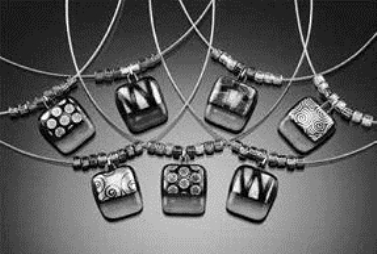
图4-64 热熔成型玻璃首饰
Figure 4-64 Fusing glass jewellery
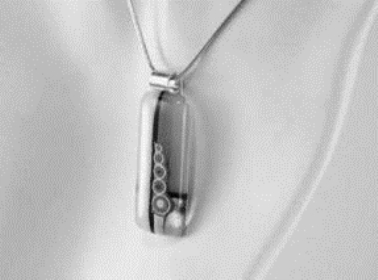
图4-65 热熔成型玻璃首饰
Figure 4-65 Fusing glass jewellery
The form of hot melt and the variety of elements used for decoration,such as the combination of linear and block glass,the use of colored glazes and metal oxides,can be found through a variety of attempts to find some special effects.
具体的操作过程为:
The specific operation process includes:
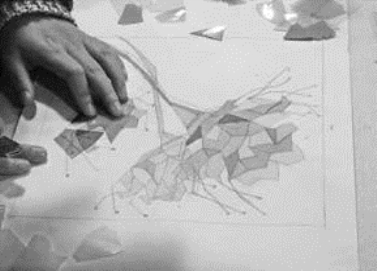
①玻璃切割。
Glass cutting.(www.daowen.com)
将所选用的彩色平板玻璃按照图案进行切割。
The selected colored flat glass is cut in a pattern.
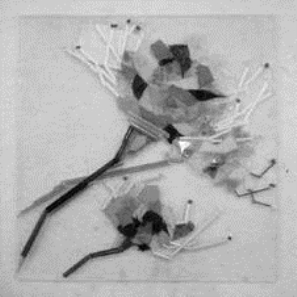
②拼贴玻璃图案。
Collage glass pattern.
将不同色彩的玻璃在石棉纸上依据设想拼成图案。
Different colors of glass are patterned on Asbestos paper according to the assumption.
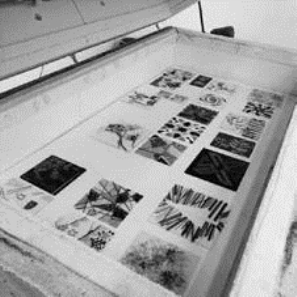
③入窑烧制。
Into the kiln for burning.
放入电窑中,设定温度(一般在700℃~800℃)进行烧制。
Place it in an electric kiln and set the temperature (usually around 700℃~ 800℃) for firing.
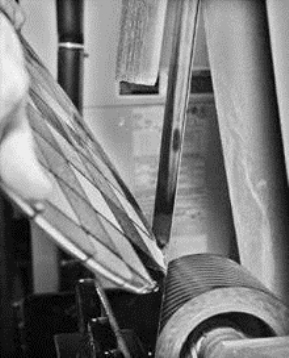
④研磨边角。
Grinding corners.
作品退火后取出,研磨边角。
After the work is annealed,it is taken out and the corners are ground.
(2)玻璃灯工工艺。
The Flamework glass.
玻璃灯工工艺用的主要设备是带调节阀的喷灯。
将具有压力的煤气-空气、煤气-氧气或氢气-氧气等混合气体送入喷灯,喷射不同温度的火焰。常用操作工具有铁钳、夹具、碳棒、打孔钢针、活塞钳、吹气工具、量具以及使火焰变成扁窄状的耐火用具等。玻璃灯工大多采取手工方式进行,大型制品采用灯工车床夹持加工,成批生产的制品采用专用机床进行机械化操作。
The main equipment used in The flame glass technology is a burner with a regulating valve.
A mixed gas such as gas-air,gas-oxygen or hydrogen-oxygen with pressure is sent to the burner to spray flames of different temperatures.Commonly used operating tools include iron tongs,clamps,carbon rods,perforated steel needles,piston tongs,air blowing tools,measuring tools,and refractory appliances that make the flames flat and narrow.Most of the glass lamp workers are carried out by hand.The large-scale products are clamped and processed by the lamp lathe,and the batch-produced products are mechanized by special machine tools.
根据加工对象,灯工分以下3种基本类型:
According to the processing object,the process is divided into the following three basic types:
①玻璃变形加工将玻璃加热软化,借外力和内腔吹气进行操作,如弯曲、吹泡、拉延、翻口边、封管底等。冷凝管球芯、蛇形芯、保温瓶胆圆底、试管翻口圆底等制品的加工属于此例。
Glass deformation processing softens the glass,and operates by external force and inner air blowing,such as bending,blowing,drawing,tumbling,sealing the bottom of the tube,and the like.The processing of products such as the condensing tube core,the serpentine core,the vitreous bottom of the thermos flask,and the round bottom of the test tube belong to this example.
②玻璃部件互相焊接玻璃烧熔后焊合整形,熔成一体,如玻璃管件对口接、丁字接、内外管套口部环接等,同种玻璃焊接最为安全。不同种的玻璃焊成的制品,如果热膨胀系数存在过大差异,焊合后冷却时将出现收缩差异,造成体积效应引起结构应力,当应力超过玻璃强度时导致炸裂。石英玻璃与普通玻璃焊接属于此例。解决的办法是采用几种热膨胀系数递变的玻璃作为中间过渡玻璃。一般而言,两种玻璃的热膨胀系数差异应小于6×10-7℃。
The glass parts are welded to each other and then welded and shaped,and melted into one body,such as glass tube fittings,butt joints,inner and outer tube sleeves,etc.,the same kind of glass welding is the safest.For products made of different kinds of glass,if there is too much difference in thermal expansion coefficient,there will be a difference in shrinkage after cooling after welding,causing structural stress caused by volume effect,and bursting when stress exceeds glass strength.Quartz glass and ordinary glass welding belong to this example.The solution is to use several glass with a coefficient of thermal expansion as the intermediate transition glass.In general,the difference in thermal expansion coefficient between the two glasses should be less than 6×10-7℃.
③玻璃部件与金属焊封。尽量采用热膨胀系数接近的玻璃与金属进行匹配封接。当两者热膨胀系数差异太大时,可选用中间过渡玻璃、性质较软的金属细丝或薄箔与玻璃进行非匹配封接,封接处产生的结构应力可通过金属变形得到补偿。
Glass parts and metal welding seals.Try to use a glass with a thermal expansion coefficient close to the metal to match the seal.When the difference between the thermal expansion coefficients of the two is too large,the intermediate transition glass,the soft metal filament or the thin foil may be used for non-matching sealing with the glass,and the structural stress generated at the sealing portion may be compensated by metal deformation.
免责声明:以上内容源自网络,版权归原作者所有,如有侵犯您的原创版权请告知,我们将尽快删除相关内容。






